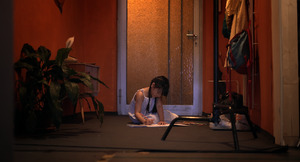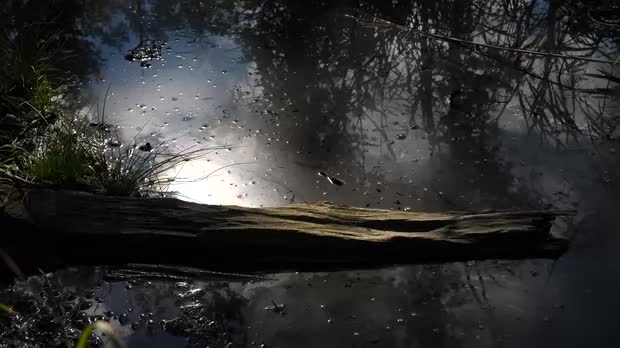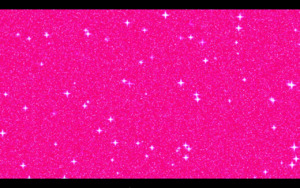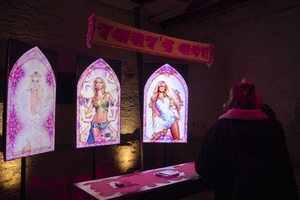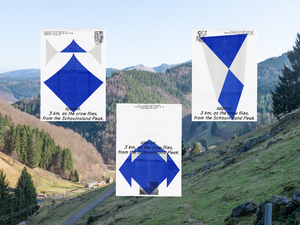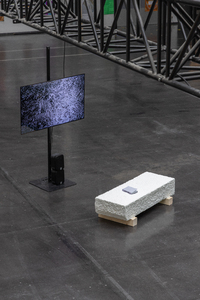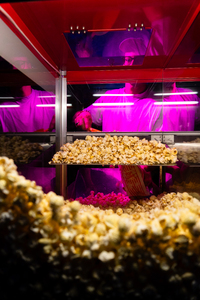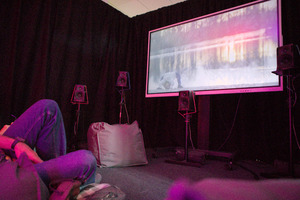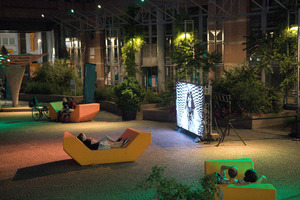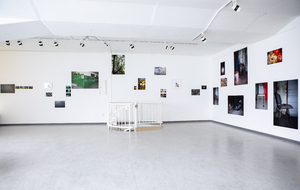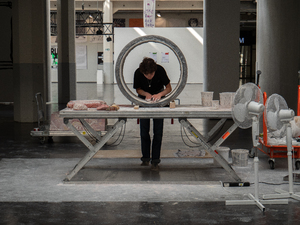"Film / Video"
| Begriff | Film / Video |
| Metakey | Typ des Projekts/Werks (creative_work:type) |
| Typ | Keyword |
| Vokabular | Werk |
21 Inhalte
Filter werden geladen
- Seite 1 von 2
so much water, so close to home
- Titel
- so much water, so close to home
- Autor/in
- Beschreibung (de)
- Als Kind wurde Minh Anh Nguyễn sexuell missbraucht. Mit ihrem 47-minütigen Essayfilm versucht sie, diesen schwierigen Teil ihres Lebens in Worte zu fassen, das Unsagbare auszusprechen und durch die Reflexion und Projektion der filmischen Praxis ein Gefühl für das eigene Selbst zurückzugewinnen. Die Filmemacherin offenbart dabei intime Gespräche mit ihrer Mutter und versucht, den schmerzhaften Prozess zu bewältigen, dieses Trauma an die Öffentlichkeit zu bringen. Mit einer zerbrechlichen Intimität bewegt sich der Film zwischen Fiktion, Archivmaterial und Dokumentation, auf der Suche nach einer Sprache, um das Vergangene auszudrücken und die Zukunft anzunehmen.
- Beschreibung (en)
- As a child, Minh Anh Nguyễn was sexually abused. Her 47-minute essay film is an attempt to put words to this difficult part of her life, to speak the unspeakable and regain a sense of self through the reflection and projection that the act of filmmaking allows. Her film reveals intimate conversations with her mother and tries to overcome the difficult process of making this trauma public. It navigates through a wounded intimacy between fiction, archive footage and documentary in search of a language to articulate the past and embrace the future.
- Kategorie
- Typ des Projekts/Werks
- Schlagworte
- Datierung
- 2025
- Mitwirkende
- Dank an
- Kathrin Beckers
- Kevin Beckmann
- Liam Birtolonu
- Matthias Bruhn
- Phuong Uyen Dao
- Christian Egerer
- Charlotte Eifler
- Kurt Glockzin
- Ute Haag
- Eva Hartmann
- Marine Hugonnier
- Fred Kelemen
- Dane Komljen
- Peter Lütje
- Phuong Thao Luu
- Malik Meyer
- Laura Morcillo
- Hai Nguyen
- Hong Anh Nguyen
- Thanh Long Nguyen
- Ludger Pfanz
- Lars Valentino Pfeiffer
- Christine Reeh
- Caroline Schwarz
- Manuel Sékou
- Thu Thao Tran
- Trinh Ngoc Tran
- Serpil Turhan
- Ha Linh Vuong
- Sprache
- Untertitel (Film)
- Material
- Technik/Verfahren/Formate
- Film
- Dauer
- 46:40 Minuten
- Stadt
- Land
- Beteiligte Institution(en)
- Titel
- so much water, so close to home
- Projektleiter/in
- Semester
- Studiengang
- Typ der Abschlussarbeit
- Externes Archiv
- Importiert am
- 14.05.2025
- Übergeordnete Sets
- 0
- Set enthält
- 0 5
block to blob - videos
- Titel
- block to blob - videos
- Titel (en)
- block to blob - videos
- Autor/in
- Kategorie
- Typ des Projekts/Werks
- Titel
- block to blob - videos
- Projektleiter/in
- Studiengang
- Typ der Abschlussarbeit
- Importiert am
- 19.11.2024
- Übergeordnete Sets
- 1
- Set enthält
- 0 6
PART 3 — Confessions
- Titel
- PART 3 — Confessions
- Autor/in
- Beschreibung (de)
- This 7-minute video goes “behind the scenes” of my fascination and reveals how i position myself in this project; the diploma is about 3 of my idols but also about me. Result of several automatic writing sessions, the text uses a plurality of voices to represent different perspectives and versions of myself: the expert, the fan, the vulnerable and the one where i become the object of my obsession.
- This 7-minute video goes “behind the scenes” of my fascination and reveals how i position myself in this project; the diploma is about 3 of my idols but also about me. Result of several automatic writing sessions, the text uses a plurality of voices to represent different perspectives and versions of myself: the expert, the fan, the vulnerable and the one where i become the object of my obsession.
- Kategorie
- Typ des Projekts/Werks
- Datierung
- 06.12.23
- Dank an
- Sprache
- Material
- Titel
- PART 3 — Confessions
- Projektleiter/in
- Semester
- Studiengang
- Typ der Abschlussarbeit
- Importiert am
- 05.11.2024
- Übergeordnete Sets
- 1
- Set enthält
- 0 4
WHERE LEGENDS ARE MADE AND LIES ARE TOLD
- Titel
- WHERE LEGENDS ARE MADE AND LIES ARE TOLD
- Autor/in
- Beschreibung (de)
- WHERE LEGENDS ARE MADE AND LIES ARE TOLD (graduation project). Originated by this divine union of @parishilton @britneyspears @lindsaylohan (aka the Holy Trinity <3) the night of the infamous Bimbo Summit, WLAMALAT is the visual and critical translation of my obsession for the #y2k it-girls and #popculture in general. Mixing a religious with a highly commercial aesthetic, the project questions several topics such as women representation in the mass media, visual/celebrity culture consumption and new belief systems.
- WHERE LEGENDS ARE MADE AND LIES ARE TOLD (graduation project). Originated by this divine union of @parishilton @britneyspears @lindsaylohan (aka the Holy Trinity <3) the night of the infamous Bimbo Summit, WLAMALAT is the visual and critical translation of my obsession for the #y2k it-girls and #popculture in general. Mixing a religious with a highly commercial aesthetic, the project questions several topics such as women representation in the mass media, visual/celebrity culture consumption and new belief systems.
- Beschreibung (en)
- WHERE LEGENDS ARE MADE AND LIES ARE TOLD (graduation project). Originated by this divine union of @parishilton @britneyspears @lindsaylohan (aka the Holy Trinity <3) the night of the infamous Bimbo Summit, WLAMALAT is the visual and critical translation of my obsession for the #y2k it-girls and #popculture in general. Mixing a religious with a highly commercial aesthetic, the project questions several topics such as women representation in the mass media, visual/celebrity culture consumption and new belief systems.
- WHERE LEGENDS ARE MADE AND LIES ARE TOLD (graduation project). Originated by this divine union of @parishilton @britneyspears @lindsaylohan (aka the Holy Trinity <3) the night of the infamous Bimbo Summit, WLAMALAT is the visual and critical translation of my obsession for the #y2k it-girls and #popculture in general. Mixing a religious with a highly commercial aesthetic, the project questions several topics such as women representation in the mass media, visual/celebrity culture consumption and new belief systems.
- Kategorie
- Typ des Projekts/Werks
- Datierung
- 06.12.23
- Dank an
- Ort
- Rudolf 5
- Titel
- WHERE LEGENDS ARE MADE AND LIES ARE TOLD
- Projektleiter/in
- Semester
- Studiengang
- Typ der Abschlussarbeit
- Importiert am
- 05.11.2024
- Übergeordnete Sets
- 0
- Set enthält
- 3 8
approx. 3km, as the crow flies, from the Schauinsland Peak.
- Titel
- approx. 3km, as the crow flies, from the Schauinsland Peak.
- Autor/in
- Beschreibung (de)
- "approx., 3km, as the crow flies, from the Schauinsland Peak." ist ein Zitat aus der Wegbeschreibung zum Zentralen Bergungsort der Bundesrepublik Deutschland (ZBO) aus dem Internationalen Register der Kulturgüter unter besonderem Schutz der UNESCO. Die Wegbeschreibung führt zum Barbarastollen, einem ehemaligen Erzbergbaustollen im Hintertal, nahe der Gemeinde Oberried im Schwarzwald.
Die Ausstellung versammelt Material in verschiedenen Formen, die den Barbarastollen und damit verbundene Aspekte erforschen. Anhand von Artefakten, die bei mehreren Besuchen im und um den Stollen herum gefunden wurden – Fotos, Geschichten, Zeitungsartikeln, E-Mails, Archivdokumenten, Ton- und Videoaufnahmen –, untersucht die Ausstellung, wie das Archiv im Stollen funktioniert und warum es noch existiert.
Themen wie Sicherheit, atomare Bedrohung, Hierarchien in der Archivauswahl, Langzeitbotschaften, Atomsemiotik, Friedensbewegung in Süddeutschland in den 80er Jahren werden verhandelt. Durch die Zusammenführung verschiedener Perspektiven auf die Idee eines zentralen Bergungsortes wurde ein Raum geschaffen, der die Besucher dazu anregt, sich kritisch mit den angesprochenen Themen auseinanderzusetzen.
- "approx., 3km, as the crow flies, from the Schauinsland Peak." ist ein Zitat aus der Wegbeschreibung zum Zentralen Bergungsort der Bundesrepublik Deutschland (ZBO) aus dem Internationalen Register der Kulturgüter unter besonderem Schutz der UNESCO. Die Wegbeschreibung führt zum Barbarastollen, einem ehemaligen Erzbergbaustollen im Hintertal, nahe der Gemeinde Oberried im Schwarzwald.
- Beschreibung (en)
- "approx., 3km, as the crow flies, from the Schauinsland Peak." is a quote from the route description to the Central Salvation Site of the Federal Republic of Germany (ZBO) from the UNESCO International Register of Cultural Property under Special Protection. The route description leads to Barbarastollen, a former ore mining tunnel in Hintertal, near the municipality of Oberried in the Black Forest.
The exhibition is gathering material of different forms researching the site of the Barbarastollen. Through several site visits inside and around the mine, photographs, stories, newspaper articles, e-mails, archival documents, sound recordings and videos investigate on how the archive works and why it still exists touching on topics of safety, nuclear threat, hierarchies in archive selections, long-time messages, atom semiotics, the peace- movement in south Germany in the 80s.
Through bringing together different perspectives on the idea of the central Salvation Site a room was created to encourage visitors to critically from their own idea on the topics addressed.
- "approx., 3km, as the crow flies, from the Schauinsland Peak." is a quote from the route description to the Central Salvation Site of the Federal Republic of Germany (ZBO) from the UNESCO International Register of Cultural Property under Special Protection. The route description leads to Barbarastollen, a former ore mining tunnel in Hintertal, near the municipality of Oberried in the Black Forest.
- Kategorie
- Typ des Projekts/Werks
- Schlagworte
- Datierung
- 05.07.2024
- Mitwirkende
- Sprache
- Material
- Ort: Institution
- Ort
- Großes Studio
- Stadt
- Land
- Titel
- approx. 3km, as the crow flies, from the Schauinsland Peak.
- Projektleiter/in
- Semester
- Studiengang
- Typ der Abschlussarbeit
- Importiert am
- 04.11.2024
- Übergeordnete Sets
- 1
- Set enthält
- 0 19
block to blob
- Titel
- block to blob
- Titel (en)
- block to blob
- Untertitel
- tracing back materiality
- Untertitel des Projekts/Werks (en)
- tracing back materiality
- Autor/in
- Beschreibung (de)
- Dieses Diplomprojekt dokumentiert den Materialstrom von synthetischen Kunststoffen durch einen rückwärtsgerichteten chronologischen Ansatz. Es kombiniert Feldforschung, visuelle Dokumentation und Materialexperimente, um die Reise von Kunststoffen von ihren Endprodukten zurück zu ihrem Ursprung im Erdöl nachzuvollziehen.
"Block to Blob" umfasst Besuche an verschiedenen Orten der Produktionskette, wie etwa Produktionsanlagen, Ölraffinerien, Pipelines und Förderstätten und endet in einem Waldökosystem, wo Rohöl auf natürliche Weise an die Erdoberfläche tritt. Diese Erfahrungen werden in einer Forschungspublikation zusammengestellt, die dieser rückwärtsgerichteten Erzählweise folgt.
Eine Videoinstallation dokumentiert die besuchten Orte und liefert einen visuellen Kontext zu den industriellen Prozessen, der verborgenen Infrastruktur und der natürlichen Substanz im Wald. Zusätzlich verankert eine Reihe von Objekten, die aus mit Erdöl beschichtetem Holz und Polystyrol gefertigt sind, das Projekt in greifbaren Materialien.
- Dieses Diplomprojekt dokumentiert den Materialstrom von synthetischen Kunststoffen durch einen rückwärtsgerichteten chronologischen Ansatz. Es kombiniert Feldforschung, visuelle Dokumentation und Materialexperimente, um die Reise von Kunststoffen von ihren Endprodukten zurück zu ihrem Ursprung im Erdöl nachzuvollziehen.
- Beschreibung (en)
- This diploma project details the material stream of synthetic plastics through a reverse chronological approach. It combines field research, visual documentation, and material experimentation to retrace the journey of plastics from their final products back to their origins in petroleum.
‘block to blob’ includes visits to various sites in the production chain, such as manufacturing facilities, oil refineries, pipelines, and extraction sites, concluding in a forest ecosystem, where crude oil naturally seeps to the earth's surface. These experiences are compiled into a research publication that follows this reverse narrative.
A video installation documents the visited locations, providing visual context for the industrial processes, hidden infrastructure and the natural substance in the forest. Additionally, a series of objects made from petroleum-coated wood and polystyrene grounds the project in tangible materials.
- This diploma project details the material stream of synthetic plastics through a reverse chronological approach. It combines field research, visual documentation, and material experimentation to retrace the journey of plastics from their final products back to their origins in petroleum.
- Kategorie
- Typ des Projekts/Werks
- Schlagworte
- Datierung
- 2024
- Sprache
- Untertitel (Film)
- Material
- Technik/Verfahren/Formate
- Pine wood coated with petroleum, Wood soaked in gasoline and pressed/bonded with polystyrene
- Abmessungen
- L x B x H mm, Petroleum-coated wooden objects: Bench: 800 x 200 x 450, 2x T-Stool: 350 x 200 x 450, Stool (3-legged): 450 x 270 x 450, Stool (wide): 600 x 450 x 450, TV stand: - Polystyrene Objekts: Counter: 500 x 370 x 1100, 2x Bench1: 1000 x 570 x 400, Bench2: 1300 x 570 x 350, Stool: 500 x 370 x 570
- Dauer
- 1.: upstream 0 - oil seeping naturally to the surface - Alsace - 2:55min, 2.: upstream 1 - prospect drilling for oil reservoirs - Weingarten - 2:17min, 3.: upstream 2 - horse head pumps extracting oil - Landau - 3:50min, 4.: midstream - transalpine pipeline - Triest-Karlsruhe - 10:40min, 5.: downstream 1 - germany biggest oil refinery - Karlsruhe - 3:13min, 6.: downstream 2 - world biggest chemical plant - Ludwigshafen - 2:19min
- Ort: Institution
- Ort
- Lichthof 3
- Stadt
- Land
- Titel
- block to blob
- Projektleiter/in
- Semester
- Studiengang
- Typ der Abschlussarbeit
- Lehrveranstaltung
- Importiert am
- 03.11.2024
- Übergeordnete Sets
- 1
- Set enthält
- 4 1
I Cried A Smile
- Titel
- I Cried A Smile
- Autor/in
- Beschreibung (de)
- Mit den Mitteln einer wissenschaftlichen Lecture erzählt „I Cried A Smile“ eine Geschichte über eine Person mit 2 Köpfen, Holz das zu Menschen wird, und die Erinnerung daran als Kind mit Neuropsychologie in Kontakt zu treten. Zwei übereinander hängende Projektionsflächen zeigen Zeichnungen, Animationen und gefundenes Bildmaterial während meine Stimme vom Band läuft und ich an einem Schreibtisch sitzend, mit dem Verfahren „Lip-Sync“ lautlos mitspreche. Das Publikum sitzt wie in einem anatomischen Theater in zwei Halbkreisen um mich herum.
- Beschreibung (en)
- Using the means of a scientific lecture, “I Cried A Smile” tells a story about a person with two heads, wood that becomes human, and the memory of coming into contact with neuropsychology as a child. Two projection screens hanging above me showcasing drawings, animations and found footage while my voice runs from the tape and I, sitting at a desk, speak along inaudibly using the “Lip-Sync” method. The audience sits around me like in an anatomical theater.
- Using the means of a scientific lecture, “I Cried A Smile” tells a story about a person with two heads, wood that becomes human, and the memory of coming into contact with neuropsychology as a child. Two projection screens hanging above me showcasing drawings, animations and found footage while my voice runs from the tape and I, sitting at a desk, speak along inaudibly using the “Lip-Sync” method. The audience sits around me like in an anatomical theater.
- Kategorie
- Typ des Projekts/Werks
- Schlagworte
- Mitwirkende
- Technik/Verfahren/Formate
- 2 Channel Video
- Dauer
- 8 Minuten
- Ort: Institution
- Stadt
- Land
- Titel
- I Cried A Smile
- Importiert am
- 30.09.2024
- Übergeordnete Sets
- 0
- Set enthält
- 0 5
Open Air Kino 2024 - Kino Im Blauen Salon
- Titel
- Open Air Kino 2024 - Kino Im Blauen Salon
- Autor/in
- Beschreibung (de)
- OPEN AIR KINO
Und auch in diesem Jahr stürmen wir hinaus auf die grüne Wiese und frönen den lauen Juni-Nächten beim HfG Open Air Kino. Wir danken dem Open-Air-Kino-Gott, dass es ihn gibt und den extra-hellen 4KW-Xenon-Kolben, die die Nacht zum Tage machen, oder zumindest an den längsten Tagen des Jahres noch etwas auf der Leinwand erkennen lassen. In diesem Jahr nicht auf zwei Wochenenden aufgeteilt sondern an einem Stück durchgeballert, erwarten euch 5 Tage Festivalstimmung mit Musik, Kurzfilmen, Drinks und lecker Essen und natürlich nicht zuletzt einige der schönsten Dinge, die die siebte Kunst in den letzten 100 Jahren so hervorgebracht hat.
- OPEN AIR KINO
- Beschreibung (en)
- OPEN AIR CINEMA
Save the Date: OPEN AIR CINEMA in front of the HfG from June 20 - 24, 2024. This year we will once again storm out onto the green meadow and indulge in the balmy June nights at the HfG Open Air Cinema. We thank the open-air cinema god that he exists and invite you to 5 days of festival atmosphere with music, short films, drinks and some of the most beautiful things (films) that the seventh art has produced in the last 100 years.
- OPEN AIR CINEMA
- Kategorie
- Typ des Projekts/Werks
- Schlagworte
- Datierung
- 20.06.2024 - 24.06.2024
- Dank an
- Ort: Institution
- Ort
- Grüne Wiese
- Stadt
- Land
- Titel
- Open Air Kino 2024 - Kino Im Blauen Salon
- Semester
- Importiert am
- 16.07.2024
- Übergeordnete Sets
- 0
- Set enthält
- 0 12
A Factor of Evolution - Triangel Studio
- Titel
- A Factor of Evolution - Triangel Studio
- Titel (en)
- A Factor of Evolution - Triangel Studio
- Autor/in
- Beschreibung (en)
- We live in times of high competition. Survival of the fittest is the omnipresent motto in most fields of human action, especially in the western world. This philosophy was only established about 200 years ago and manifested by Charles Darwin and especially the Social Darwinists at the end of the 19th century. They believed that according to a law of nature, only the physically strongest and most aggressive individuals and species would survive in the struggle for life. Many Social Darwinists justified therefore capitalism and racism with devastating consequences in the coming decades until nowadays.
Peter Kropotkin is attempting in his philosophical work Mutual Aid: A Factor of Evolution (1902) to dismantle their arguments and based on numerous observations of zoologists and anthropologists, he proves, that the fittest species are the most sociable ones and that sociability develops intelligence, which is the most powerful arm in the struggle for survival. This includes insects, animals and humans. Higher moral sentiments and compassion is also essential for survival in all societies.
The ritual burning of sage in nature should help to cleanse the negative energy of social darwinism in our world and make room for a more cooperative society, that will secure the well-being of all members, even the most weak ones and furthermore facilitate a more sustainable, safe and content society.
- We live in times of high competition. Survival of the fittest is the omnipresent motto in most fields of human action, especially in the western world. This philosophy was only established about 200 years ago and manifested by Charles Darwin and especially the Social Darwinists at the end of the 19th century. They believed that according to a law of nature, only the physically strongest and most aggressive individuals and species would survive in the struggle for life. Many Social Darwinists justified therefore capitalism and racism with devastating consequences in the coming decades until nowadays.
- Typ des Projekts/Werks
- Schlagworte
- Datierung
- 07.06.2024
- Mitwirkende
- Beteiligte Institution(en)
- Titel
- A Factor of Evolution - Triangel Studio
- Importiert am
- 05.06.2024
- Übergeordnete Sets
- 1
- Set enthält
- 0 14
ECHOS AND ARCHIVES Part II: Im Strudel der Daten und flüchtigen Scheine
- Titel
- ECHOS AND ARCHIVES Part II: Im Strudel der Daten und flüchtigen Scheine
- Autor/in
- Beschreibung (de)
- Das Künstler*innen Kollektiv Francis Karat mobilisiert für die Bunte Nacht der Digitalisierung KI-Modelle und lässt sie die Abstraktionen der Verwaltung 4.0 halluzinieren. Die Gedanken eines Maschinenaufsehers aus der Zukunft verlieren sich in einer futuristischen Reimagination des Markerschen Fotoromans. Durch ein Rearrangement der bekannten gelben Straßenblockaden bricht die Geschichte aus der Leinwand heraus und interagiert mit dem Kronenplatz.
- Kategorie
- Typ des Projekts/Werks
- Schlagworte
- Datierung
- 07.06.2024
- Ort: Institution
- Ort
- Kronenplatz
- Stadt
- Land
- Beteiligte Institution(en)
- Titel
- ECHOS AND ARCHIVES Part II: Im Strudel der Daten und flüchtigen Scheine
- Importiert am
- 05.06.2024
- Übergeordnete Sets
- 1
- Set enthält
- 0 32
Das ist ein Kinderspiel, not an Apple, 也就⼋年
- Titel
- Das ist ein Kinderspiel, not an Apple, 也就⼋年
- Autor/in
- Beschreibung (de)
- Das ist ein Kinderspiel, not an Apple, 也就八年 ist meine erste Einzelausstellung, sowie mein Abschlussprojekt. Es ist eine tief persönliche Reflexion über meine Erfahrungen in Deutschland, die meinen künstlerischen Ansatz und mein konzeptionelles Denken maßgeblich geprägt haben. Mein Fokus auf sprachlichen Herausforderungen, kulturelle Kollisionen und die Gegenüberstellung verschiedener Welten ist in meiner Arbeit deutlich erkennbar.
Indem ich Fotografie als meine primäre Sprache nutze, konzentriere ich mich auf das alltägliche Leben, das in den Ecken der Städte verborgen ist – gesehen, aber vergessen, wie die Stuttgarter Straße in Karlsruhe. Dieses Thema wurde besonders deutlich, als ich nach der Pandemie in meine Heimatstadt zurückkehrte. Ich beobachte aufmerksam die marginalisierten Bereiche meiner Heimatstadt und die oft unsichtbaren Aspekte des täglichen Lebens meiner Familie. Diese sowohl ungewohnte als auch vertraute Perspektive vertieft sich in die Frage, wie das Leben in Deutschland meine Weltanschauung beeinflusst hat. Es betont die Komplexitäten, die aus Konflikten zwischen Sprachen und Kulturen entstehen.
Durch Fotografie, Video, Live-Performance und Publikation webe ich ein Netz aus Zeit, das Individuen, Ereignisse und Objekte aus parallelen Zeitlinien miteinander verknüpft. Jedes Fragment eingefrorener Zeit erzählt seine eigne Geschichte und präsentiert eine einzigartige Erzählung – sei es aus einer einheimischen Perspektive oder durch die Linse einer neuen Beobachtung, die durch eigne Erfahrungen in Deutschland geprägt ist.
Meine acht Jahre Leben in Deutschland scheinen in dieser acht Jahre alten Apfelkerzen eingefroren zu sein, sich entwickelnd und eine neue Form annehmend, während sie brennt und sich die Zeit ändert.
https://hangyanchen.de/
- Das ist ein Kinderspiel, not an Apple, 也就八年 ist meine erste Einzelausstellung, sowie mein Abschlussprojekt. Es ist eine tief persönliche Reflexion über meine Erfahrungen in Deutschland, die meinen künstlerischen Ansatz und mein konzeptionelles Denken maßgeblich geprägt haben. Mein Fokus auf sprachlichen Herausforderungen, kulturelle Kollisionen und die Gegenüberstellung verschiedener Welten ist in meiner Arbeit deutlich erkennbar.
- Beschreibung (en)
- My graduation project is a deeply personal reflection on my experiences living in Germany, which have significantly shaped my artistic approach and conceptual thinking. I focus on language challenges, cultural collisions, and the juxtaposition of different worlds, all of which are evident in my work.
Using photography as my primary language, I focus on the everyday life hidden in the corners of cities – seen but forgotten, such as Stuttgarter Street in Karlsruhe. This theme became particularly pronounced upon my return to my hometown after the pandemic. I keenly observe the marginalized areas of my hometown and the neglected aspects of my family's daily life. This both unfamiliar and familiar perspective delves into how living in Germany has impacted my worldview, emphasizing the complexities arising from conflicts between languages and cultures.
Through photography, video, live performance, and publication, I weave a web of time, intertwining individuals, events, and objects from parallel timelines. Each fragment of frozen time tells its own story, presenting a unique narrative – whether as a native perspective or through the lens of a new observation shaped by my experiences in Germany.
- My graduation project is a deeply personal reflection on my experiences living in Germany, which have significantly shaped my artistic approach and conceptual thinking. I focus on language challenges, cultural collisions, and the juxtaposition of different worlds, all of which are evident in my work.
- Kategorie
- Typ des Projekts/Werks
- Schlagworte
- Datierung
- 19.01.2024 - 25.01.2024
- Mitwirkende
- Ort
- GEDOK, Karlsruhe
- Stadt
- Land
- Titel
- Das ist ein Kinderspiel, not an Apple, 也就⼋年
- Urheberrechtshinweis
- ©Hangyan Chen
- Projektleiter/in
- Semester
- Studiengang
- Typ der Abschlussarbeit
- Importiert am
- 31.05.2024
- Übergeordnete Sets
- 2
- Set enthält
- 0 26
Vordiplom Hannah Gebert
- Titel
- Vordiplom Hannah Gebert
- Titel (en)
- "fake it till you make it"
- Autor/in
- Beschreibung (de)
- Stuckmarmor ist eine historische Stucktechnik des 16. und 17. Jahrhunderts aus Italien, die für ihre Marmorimitation bekannt ist. Dabei wurden Gips, Wasser, Pigmente und tierischer Leim gemischt, um marmorähnliche Oberflächen zu schaffen.
"Fake it till you make it" ist eine Erkundung dieses traditionellen Handwerks. Ziel ist es, die alte Kunst der Marmorimitation wiederzubeleben und ihre ästhetischen Werte in der heutigen Welt zu präsentieren. Darüber hinaus befasst sich das Projekt mit der Frage, was "echt" und was "unecht" ist, und untersucht die Rolle der Inszenierung. Inspiriert von den drei Teilen einer Säule (Basis, Schaft, Kapitell) habe ich drei Objekte entwickelt, die als Einzelstücke im Raum zu finden sind. Alle drei Objekte sind aus Holz gefertigt, zwei davon durch ein Stahlgerüst stabilisiert. Die Unterkonstruktion wurde dann mit Streckmetall verkleidet, verputzt und diente schließlich als Untergrund für den Stuckmarmor. Ein Making-of-Video zeigt die Herstellung des Stuckmarmors. Jedes der Objekte ist auf eine andere Art und Weise verkleidet, um die Konstruktion nicht immer zu verbergen, sondern sie vielmehr zu enthüllen, ganz nach dem Motto "fake it till you make it".
- Stuckmarmor ist eine historische Stucktechnik des 16. und 17. Jahrhunderts aus Italien, die für ihre Marmorimitation bekannt ist. Dabei wurden Gips, Wasser, Pigmente und tierischer Leim gemischt, um marmorähnliche Oberflächen zu schaffen.
- Beschreibung (en)
- Stucco marble is a historic plasterwork technique originating from 16th and 17th-century Italy, celebrated for its imitation of marble. This involved blending gypsum plaster, water, pigments, and animal glue to create marble-like surfaces.
„fake it till you make it“ is an exploration of this traditional craft of stucco marble. The aim is to revive the ancient art of imitating marble and to present its aesthetic values in today‘s world. In addition, the project will address the question of what is „real“ and what is „fake“ and examine the role of staging. Inspired by the three parts of a column (base, shaft, capital) I have developed three objects that can be found as individual pieces in the room. All three objects are made of wood, two of them stabilized by a steel framework. Ribbed expanded metal lath was then stapled onto the wood and plastered, serving as the base for the stucco marble. A making of video shows the production of the stucco marble. Each of the objects is covered in a different way, intended not to always conceal the construction but rather to reveal it, embodying the spirit of „fake it till you make it.“
- Stucco marble is a historic plasterwork technique originating from 16th and 17th-century Italy, celebrated for its imitation of marble. This involved blending gypsum plaster, water, pigments, and animal glue to create marble-like surfaces.
- Kategorie
- Typ des Projekts/Werks
- Schlagworte
- Datierung
- 25.06.2024
- Material
- Ort: Institution
- Ort
- An der Säule unter der Lichtbrücke
- Stadt
- Land
- Titel
- Vordiplom Hannah Gebert
- Projektleiter/in
- Studiengang
- Importiert am
- 22.05.2024
- Übergeordnete Sets
- 1
- Set enthält
- 0 13
